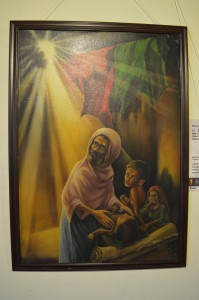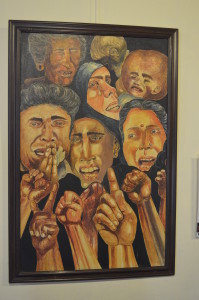
 Creative works based on religious themes have always been a delicate area for artists. In a rare attempt to translate the Holy Qur’an into the language of colours, a group of painters have drawn inspiration from selected verses from the text which prompt readers to look for signs of God in his surroundings. Organised as part of Kochi-Muziris Biennale, the Art of Light at Fadi building in Mattanchery, showcases works of 20 upcoming artists from across the state who approach the holy text for inspiration. Interestingly, the show also includes works of a few non-Muslim artists reflecting their understanding of the text. The show begins with a huge mirror which reflects the visitor and when he looks for an explanation, it points to a verse which reads, “We have created man in best form,” from a chapter in Qur’an called The Fig. The verse prompts the reader to think about his own creation in which he has no role but comes as a gift of God. Though Qur’an is generally considered a religious text comprising injunctions for the believers, most of the artists have approached the text through a different prism reflecting the sign of God in the creation of universe — rivers, mountains, rain, changing of day and night explained in various chapters in Qur’an like, The Tiding, The Bee, The Merciful, The Children of Israel etc. Apart from nature, a few works also reflect the strong call of the holy text for social justice and the responsibility of believers to stand up for truth and justice. C Abdul Salam’s work on victims of violence and deprivation reminds the viewer about victims of Endosulfan, struggles of women and adivasis and victims of the 2002 Gujarat pogrom. The painting is based on a verse in Quran which reads, “How is that you don’t fight in the way of Allah in support of the helpless men, women and children” from a chapter titled The Women. According to scholars this is one of the most important verses in Quran which exhorts believers to stand for the oppressed irrespective of religion and fight for their rights. Yahya PH’s work reflects another pressing social problem of our times, female infanticide, against which Qur’an admonishes believers — “Don’t kill your children for fear of want. We will provide them and for you. Surely killing them is the greatest sin”. There are also a few works which deals with historical events explained in the holy text. Athira SB’s painting on Ad, Thamud communities who hewed building out of rocks, points to a story explained in chapter 89 Al Fajr in Qur’an. “It has been widely accepted that Quran is a text with high literary content. The text has also a huge visual possibility which still remains unexplored. The show is an attempt to explore the visual possibility of the text,” said Adam Ayyub, president, Thanima Kala Sahythia Vedi, which organized the show. Traditionally, it is understood that art and music is alien to Islam. However, contemporary readings and deeper understanding of the Qur’an have opened up new vistas of knowledge and it has also inspired art, music and literature among believers across the world, he said. “In this hurried world where people don’t have time to read or listen to, visual art has a huge possibility in communicating messages. Art is an understanding and these paintings reflect the understanding of holy Qur’an by different artists,” said noted sculptor Valsan Koorma Kalleri.
Creative works based on religious themes have always been a delicate area for artists. In a rare attempt to translate the Holy Qur’an into the language of colours, a group of painters have drawn inspiration from selected verses from the text which prompt readers to look for signs of God in his surroundings. Organised as part of Kochi-Muziris Biennale, the Art of Light at Fadi building in Mattanchery, showcases works of 20 upcoming artists from across the state who approach the holy text for inspiration. Interestingly, the show also includes works of a few non-Muslim artists reflecting their understanding of the text. The show begins with a huge mirror which reflects the visitor and when he looks for an explanation, it points to a verse which reads, “We have created man in best form,” from a chapter in Qur’an called The Fig. The verse prompts the reader to think about his own creation in which he has no role but comes as a gift of God. Though Qur’an is generally considered a religious text comprising injunctions for the believers, most of the artists have approached the text through a different prism reflecting the sign of God in the creation of universe — rivers, mountains, rain, changing of day and night explained in various chapters in Qur’an like, The Tiding, The Bee, The Merciful, The Children of Israel etc. Apart from nature, a few works also reflect the strong call of the holy text for social justice and the responsibility of believers to stand up for truth and justice. C Abdul Salam’s work on victims of violence and deprivation reminds the viewer about victims of Endosulfan, struggles of women and adivasis and victims of the 2002 Gujarat pogrom. The painting is based on a verse in Quran which reads, “How is that you don’t fight in the way of Allah in support of the helpless men, women and children” from a chapter titled The Women. According to scholars this is one of the most important verses in Quran which exhorts believers to stand for the oppressed irrespective of religion and fight for their rights. Yahya PH’s work reflects another pressing social problem of our times, female infanticide, against which Qur’an admonishes believers — “Don’t kill your children for fear of want. We will provide them and for you. Surely killing them is the greatest sin”. There are also a few works which deals with historical events explained in the holy text. Athira SB’s painting on Ad, Thamud communities who hewed building out of rocks, points to a story explained in chapter 89 Al Fajr in Qur’an. “It has been widely accepted that Quran is a text with high literary content. The text has also a huge visual possibility which still remains unexplored. The show is an attempt to explore the visual possibility of the text,” said Adam Ayyub, president, Thanima Kala Sahythia Vedi, which organized the show. Traditionally, it is understood that art and music is alien to Islam. However, contemporary readings and deeper understanding of the Qur’an have opened up new vistas of knowledge and it has also inspired art, music and literature among believers across the world, he said. “In this hurried world where people don’t have time to read or listen to, visual art has a huge possibility in communicating messages. Art is an understanding and these paintings reflect the understanding of holy Qur’an by different artists,” said noted sculptor Valsan Koorma Kalleri.